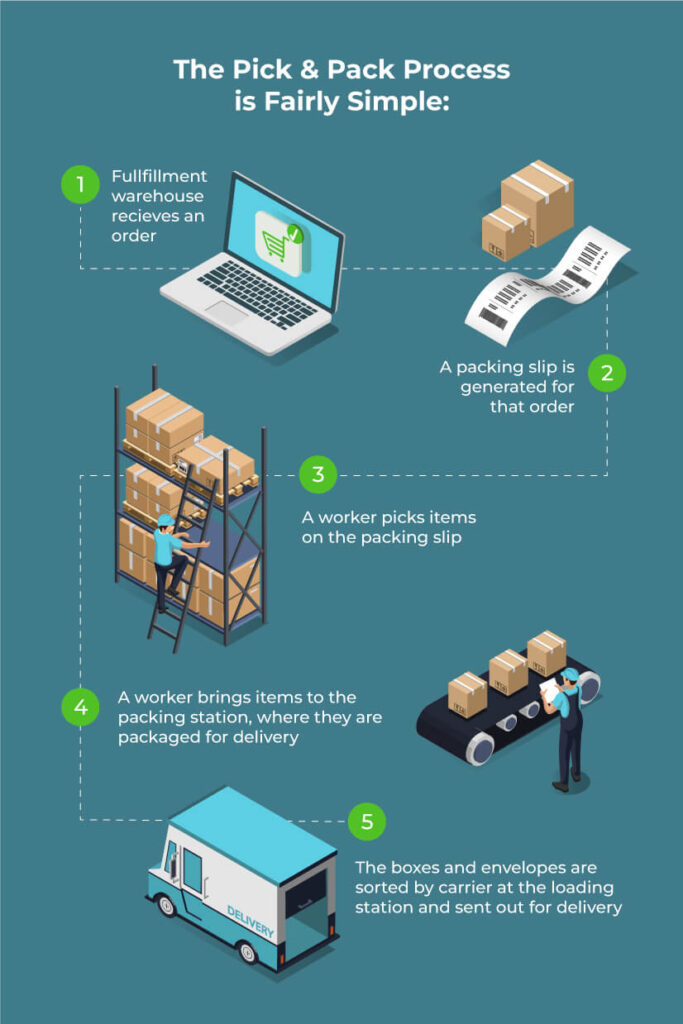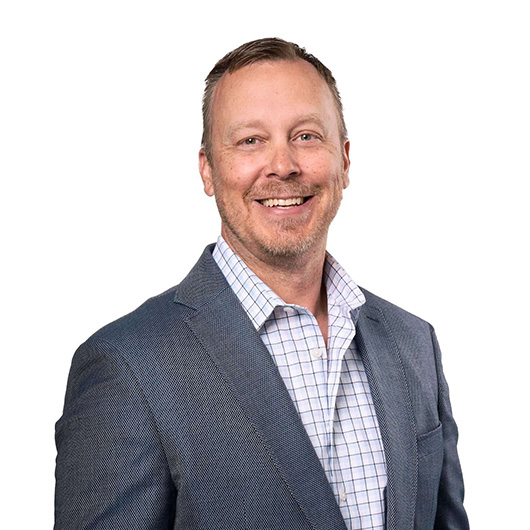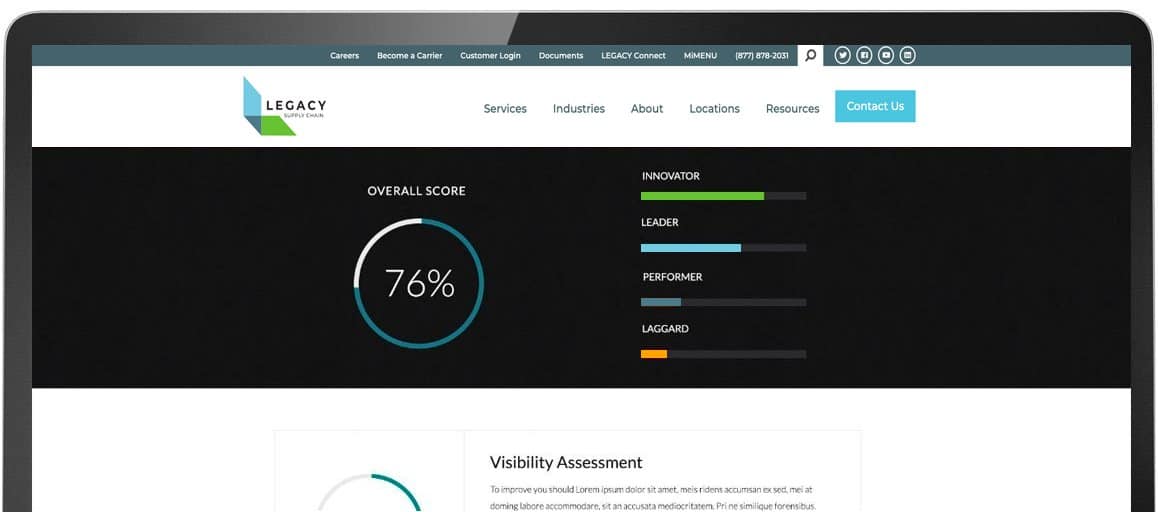Pick and Pack: The 5 Keys to Improved ECommerce Fulfillment

Once a niche market dominated by online-only players, eCommerce is now a prominent feature within the retail landscape, and an integral component of nearly every retailer’s business strategy. According to data from Statista, over two billion people purchased goods or services online in 2020, and eCommerce sales surpassed $4.2 trillion USD worldwide. Forecasts indicate that the eCommerce market will continue to grow at an accelerated rate, with projected revenues of $6.3 trillion USD by 2024.

In order to maintain a competitive edge in this incredibly lucrative market, dedicated online retailers and traditional retailers with eCommerce channels alike must find ways to become leaner and more efficient, starting with their order fulfillment process. An excellent way to achieve this is to make pick and pack fulfillment part of your larger order fulfillment strategy.
In this article, we’ll take a closer look at pick and pack fulfillment — what it is, benefits to using it, popular methods and more.
- What is Picking and Packing?
- The Benefits of Pick and Pack Fulfillment
- Popular Pick and Pack Methods
- Pick and Pack Warehouse Organization
- Pick and Pack Fulfillment Best Practices
- Let Legacy Take the Lead
- Pick and Pack FAQs
What is Picking & Packing?
Pick and pack — sometimes known as pick, pack and ship — is an order fulfillment method in which workers pick individual items from warehouse shelves and package them for shipment onsite. It derives its name from two separate logistics activities:
- Picking: The process of retrieving items from a storage location to fulfill a specific order or requirement
- Packing: The process of arranging and preparing items for shipment or transport, ensuring their safe and efficient handling during transit
The pick and pack process is fairly simple:

Pick and pack fulfillment has evolved with eCommerce retailers as they look to drive more efficiency, cost effectiveness and rapid turnaround times. To illustrate this, consider the pick and pack process compared to traditional order fulfillment.
Traditional order fulfillment for retailers involves pulling entire crates or pallets of goods — a process that typically requires the support of multiple warehouse workers and the use of equipment such as forklifts and pallet trucks. Traditional order fulfillment also typically originates from a large-scale distribution center or cross-dock for sorting before they’re sent out for delivery to a store or other retail location.
Pick and pack fulfillment eliminates the “middleman” — the store — from the process, instead packaging and sorting orders for delivery direct to the end consumer. In doing so, pick and pack fulfillment allows for faster turnaround times and enables retailers to fulfill high volumes of eCommerce orders at a more rapid rate.
Pick, pack and ship is typically considered a form of value-added service because it goes beyond standard warehousing services and streamlines the order fulfillment process.
The Benefits of Pick and Pack Fulfillment
One of the most common fulfillment methods, pick, pack and ship is popular for its ability to streamline the entire order fulfillment process. Here are just a few of the benefits you can expect by adopting pick and pack fulfillment for your business:
- Greater efficiency: By selecting items from inventory and packaging them into individual orders, businesses can reduce handling times and optimize efficiency. This optimized efficiency translates to faster order processing and reduced delivery times, which can help businesses meet heightened customer expectations around order delivery. This efficiency extends to orders of all sizes, making pick and pack a flexible, scalable fulfillment method capable of meeting seasonal demands and supporting promotional campaigns.
- Fewer errors: Pick and pack fulfillment focuses on carefully retrieving and packaging individual orders based on specific guidelines. This narrow focus and attention to detail reduces the risk of workers mixing up products when packaging orders. Additionally, many pick and pack systems incorporate barcode scanning and other technology to verify item accuracy and further enhance the precision of the fulfillment process. With this increased order accuracy comes fewer returns and greater overall customer satisfaction.
- Optimized inventory: Because of its individualized approach to order fulfillment, pick and pack offers real-time visibility into available inventory. As items are picked for orders, inventory management systems are updated, allowing for accurate tracking of stock levels and enabling businesses to maintain optimal inventory levels and avoid overstocking or stockouts. In order for picking and packing to work, inventory must be well-organized, which also allows for more efficient space utilization and reduces the need for excess storage.
- Cost-savings: Pick and pack fulfillment is an exercise in efficiency, one that emphasizes finding smarter, more effective ways to process and fulfill orders. This eye for efficiency extends to all aspects of the fulfillment process, from systematically organizing products and optimizing warehouse layout to reduce the time and effort required to locate and retrieve items to consolidating items into fewer packages through effective packing. These operational efficiency enhancements enable businesses to reduce the risk of costly returns, lower their carrying costs and improve resource utilization.
- Customization options: Some third-party logistics (3PL) companies offer customized packaging as part of their pick and pack services, enabling businesses to add special designs or details to their packages to enhance brand recognition. And because pick and pack orders are packaged individually, businesses can also add special inserts unique to that particular order or to the customer, creating a memorable experience for end consumers and improving their satisfaction.
Popular Pick & Pack Methods
Similar to traditional order fulfillment, you can take a few different approaches to picking and packing, including:
- Piece Picking: This is the process by which a worker picks and packs a single order at a time. Piece picking is a simple, straightforward and efficient approach to picking and packing for small businesses that manage their own warehousing operations, however, it poses challenges for larger eCommerce retailers with a high volume of incoming orders.
- Batch Picking: Rather than pick and pack orders one at a time, with batch picking, warehouse workers pick orders in batches and bring them to packing stations all in one go. This method enables eCommerce retailers to maximize picker productivity and send out multiple orders at a time, making it an excellent option for eCommerce retailers of all sizes who manage their own warehouse operations.
- Zone Picking: With zone picking, workers pick and pack partial orders based on their location, or “zone” within the warehouse. Once a worker has completed their portion of the picking list, they pass it off to the next picker in the next zone — and so on and so forth — until the completed order finally reaches the packing station. Zone picking is highly efficient but requires complex coordination across multiple different members of warehouse staff, meaning it may be better suited for larger eCommerce retailers than small online businesses.
- Wave Picking: Wave picking combines the best of batch picking and zone picking. Here’s how it works: Workers pick and pack batches of orders within their designated zone before passing that batch of orders off to workers in the next zone. The process repeats until each batch of orders is complete, at which point they’re sent to the packing station. Wave picking works best when orders can be grouped together by the items they include, delivery deadlines and so on. This pick and pack method is suitable for businesses of all sizes but, similar to zone picking, requires a level of coordination that may be more attainable for larger eCommerce retailers.

Pick and Pack Warehouse Organization
One of the keys to implementing a successful pick and pack fulfillment process is to organize your warehouse in such a way that your workers can quickly and efficiently locate and retrieve items for orders. Some of the most popular warehouse organization techniques for picking and packing include:
- Like-with-like: As its name implies, this technique involves arranging similar products in close proximity to each other. This approach groups together items that share common characteristics, such as size, type or category.
- Volume-based: With this technique, inventory is arranged based on the frequency and volume of product movement. Items with higher sales or demand are strategically positioned closer to pick zones or the shipping area, while slower-moving products are placed toward the back of the warehouse.
- Chaotic: Also known as “randomized storage,” items are stored wherever there is available space, rather than grouped together logically. While this method may seem counterintuitive and even disorganized, it allows for dynamic placement of goods, making it a flexible approach for facilities with changing needs.
- Class-based: This organizational system involves categorizing inventory into classes or groups based on factors such as item value, demand frequency or storage requirements and allocating space for them accordingly. For example, high-value or fast-moving items might be positioned in easily accessible areas, while lower-value or slower-moving items are stored further away.
- Mobile shelf-based: This technique utilizes mobile shelving units — often designed to move along tracks or rollers — that can be reconfigured or relocated to optimize space utilization and enhance accessibility. Mobile shelf-based storage is especially useful for high-density storage of small to medium-sized items because it maximizes vertical space and reduces the need for fixed aisles.
Pick & Pack Fulfillment Best Practices
Regardless whether your eCommerce business — or your warehouse — is large or small, there are a few basic best practices you should follow to ensure that the picking and packing process moves as smoothly as possible:
- Choose the pick and pack method that makes the most sense for your business. As discussed, certain approaches to picking and packing are better suited for small businesses, while others are ideal for large eCommerce retail operations. When deciding which pick and pack method to use, be sure to factor in your average volume of incoming orders, how many warehouse employees you have and the size of your warehouse. Ultimately, your pick and pack method should reduce worker movement as much as possible in order to create a more efficient flow across your warehouse floor.
- Identify the right inventory organization strategy. Which strategy you choose will depend on which pick and pack method you follow. For example, if you plan to utilize zone picking or wave picking, you might consider grouping like items in order to create different zones. Or, if you intend to use piece picking or batch picking, you may want to adopt a volume-based system, in which popular items are placed closer to the packing system, to save workers time. Your inventory organization strategy will also impact efficiency, so again, it’s important to reduce worker movement where possible.
- Arrange items to minimize touches during the picking and packing process. Now that we’ve talked about how to organize inventory on the warehouse floor, let’s discuss how to organize items on warehouse shelves. In an ideal world, pickers would never have to sort through different items to find the product they’re looking for. Instead, they’d simply grab the item they needed and go.In reality, there are some items that will only require one touch, and others that will require a few — the key is to reduce touches wherever possible. In order to do so, avoid storing items far back on the shelf, where they’re more difficult to reach, or in small containers that might be hard to open. Clearly label items and position them so that those labels are easily visible from the warehouse floor. Arranging items on warehouse shelves in a way that is logical, intuitive and minimizes touches when picking not only supports efficiency goals — it also helps reduce the risk of human error.
- Avoid errors by doing your due diligence. Pick and pack fulfillment is a great way to avoid packaging errors because orders are packaged on an individual basis, rather than in bulk. That means each order receives individual attention from workers and can easily be double-checked for quality purposes.With that said, workers must carefully review packing slips when selecting and again before sealing up boxes to ensure that they haven’t retrieved the wrong products and that the order isn’t missing any items. Technology can help — using barcode systems, workers can rescan items when packing up orders to make sure they’ve included everything from the packing list.
- Introduce automation where you can. For larger eCommerce operations with the means to do so, investing in an automated storage and retrieval system can be a valuable way to accelerate the picking and packing process. But that doesn’t mean small businesses can’t get in on the automation game: Smaller changes, such as installing conveyor belts and using barcode scanners, are impactful ways to automate warehouse tasks and enhance picking and packing efficiency.
- Invest in a warehouse management system (WMS). Many of the pick and pack best practices shown here can be more easily implemented using a WMS. WMS technology is proven to provide real-time visibility into the status of orders, identify opportunities for workflow optimization, support automation through purchase order system integration and even intelligently design more efficient processes, all in service of streamlining pick and pack order fulfillment.
- Outsource pick and pack fulfillment to a qualified professional. Although picking and packing is a highly efficient approach to fulfillment, it takes significant time and resources to implement on your own. To achieve the benefits of pick and pack fulfillment without a high investment, consider partnering with a 3PL company. These companies have the existing infrastructure, technology and workforce to support pick, pack and ship, as well as the proven expertise to help you streamline your fulfillment operations.
Let Legacy Take the Lead
Need help optimizing order fulfillment for your eCommerce operation? Legacy Supply Chain is here to lead the way. We specialize in providing high-touch fulfillment warehousing services, delivering decades’-worth of operational expertise and supplying the most advanced order fulfillment solutions, so you can fulfill the promises you make to your customers.
To learn more about Legacy’s fulfillment warehousing, or any of our other service options, contact us today.
Pick & Pack FAQs
Q: What is pick and pack order fulfillment?
A: Pick and pack order fulfillment is the process by which workers — also known as pickers — pick items from warehouse shelves and package them in individual boxes or envelopes. Pick and pack, which is sometimes referred to as pick, pack and ship, is different from traditional order fulfillment in that orders are packaged for shipment and delivery onsite, rather than sent to a distribution center.
Pick and pack fulfillment is typically reserved for smaller orders and is considered a value-added service because it exceeds standard warehousing services and streamlines the order fulfillment process.
Q: Are there different pick and pack fulfillment methods?
A: Yes. The four most common pick and pack fulfillment methods are piece picking, batch picking, zone picking and wave picking.
Q: What are the benefits of picking and packing?
A: Pick and pack is more cost-efficient and offers faster turnaround times than traditional order fulfillment strategies, making it a popular option for eCommerce retailers.
Q: How much do pick and pack services typically cost?
A: The answer to that question depends on a number of factors, including how many online orders you receive per day/week/month, assembly instructions for your product(s), how you package orders and so on. To get a custom quote, please contact Legacy’s sales team today.
Get Insights. Stay Ahead.
Get the latest news and insights via email on warehouse improvement, transportation optimization, labor strikes and international shipping rate changes.Popular Posts
Search Posts
-
Baltimore Bridge Impact Assessment – Update
Following the recent Baltimore Bridge collapse and subsequent port closures, we want to keep our customers informed about the situation and...
+ Read more -
Global Momentum Builds for Charge on Global Shipping Sector’s CO2 Emissions
A growing coalition of 47 countries, including key players like the European Union, Canada, Japan, and various Pacific Island nations, is...
+ Read more -
5 Key Components in International Contingency Planning
The global logistics outlook indicates a lingering crisis mode, requiring adaptation to the new normal of accelerated global disruptions,...
+ Read more










